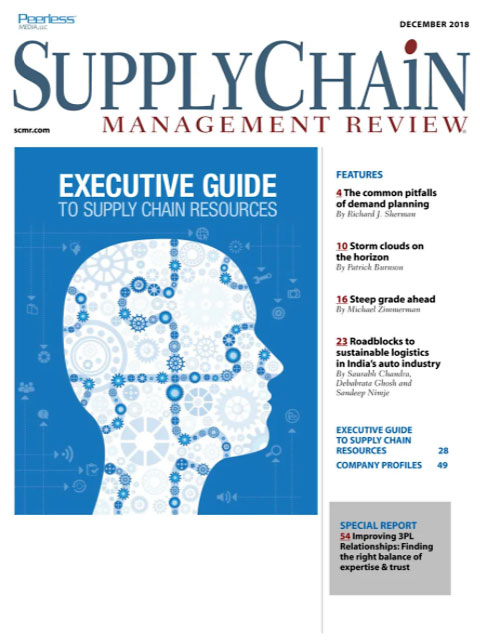Sorry, but your login has failed. Please recheck your login information and resubmit. If your subscription has expired, renew here.
December 2018
It’s December and time once again for our annual Executive Guide to Supply Chain Resources. This is a comprehensive guide to services, products and educational opportunities targeted specifically to supply chain professionals. As with years past, we’re also featuring several articles we trust will offer food for thought in your supply chain in the coming year. Browse this issue archive.Need Help? Contact customer service 847-559-7581 More options
Rising volumes. Capacity shortages. Bold price increases. Across all sectors, for all types of shippers. Through most of 2017 and 2018, the story of logistics industry has been inflationary. It simply costs more to move and store things now than in the past. And in general, this trend is likely to continue, according to the Council of Supply Chain Management Professionals’ 2018 State of Logistics Report authored by A.T. Kearney.
Reduced available capacity and high prices have resulted in large part from a strong economy. Most indicators call for the strong economy to continue through 2019 and beyond, despite some recent wobbles and concern that the Fed rate increases will trigger a recession. The capacity crunch has not been helped by uncertainty about big, technology-driven changes coming to most sectors of the industry. While those changes are indeed coming and will be profound, they are not likely to arrive soon enough to make a difference in 2019. Thus, shippers will need smart strategies to address the complex tradeoffs inherent in a tight logistics market.
The industry outlook is clearer than it was a year ago. Back then, uncertainties suggested four different scenarios for how 2018 would play out. This year, all trends point to a single scenario: a steep grade ahead. As demand outpaced supply in every sector of logistics, carriers have been in control. A variety of factors—from high fuel costs to constricted labor markets—will conspire to keep prices high. To contain costs and ensure stability, shippers must become more efficient, in part by leveraging emerging technological tools.

This complete article is available to subscribers only.
Log in now for full access or start your PLUS+ subscription for instant access.
SC
MR
Sorry, but your login has failed. Please recheck your login information and resubmit. If your subscription has expired, renew here.
December 2018
It’s December and time once again for our annual Executive Guide to Supply Chain Resources. This is a comprehensive guide to services, products and educational opportunities targeted specifically to supply chain… Browse this issue archive. Access your online digital edition. Download a PDF file of the December 2018 issue.Rising volumes. Capacity shortages. Bold price increases. Across all sectors, for all types of shippers. Through most of 2017 and 2018, the story of logistics industry has been inflationary. It simply costs more to move and store things now than in the past. And in general, this trend is likely to continue, according to the Council of Supply Chain Management Professionals' 2018 State of Logistics Report authored by A.T. Kearney.
Reduced available capacity and high prices have resulted in large part from a strong economy. Most indicators call for the strong economy to continue through 2019 and beyond, despite some recent wobbles and concern that the Fed rate increases will trigger a recession. The capacity crunch has not been helped by uncertainty about big, technology-driven changes coming to most sectors of the industry. While those changes are indeed coming and will be profound, they are not likely to arrive soon enough to make a difference in 2019. Thus, shippers will need smart strategies to address the complex tradeoffs inherent in a tight logistics market.
The industry outlook is clearer than it was a year ago. Back then, uncertainties suggested four different scenarios for how 2018 would play out. This year, all trends point to a single scenario: a steep grade ahead. As demand outpaced supply in every sector of logistics, carriers have been in control. A variety of factors—from high fuel costs to constricted labor markets—will conspire to keep prices high. To contain costs and ensure stability, shippers must become more efficient, in part by leveraging emerging technological tools.
SC
MR


More Events
- Looking back at NextGen 2024
- Mattel’s CSCO shares insights on managing change
- NextGen Supply Chain Conference set for October 21-23
- Estée Lauder, Schneider Electric and S&S Activewear to receive NextGen End User awards
- 2024 Robotics Application Conference announces session, speaker lineup
- NextGen Supply Chain Conference announces Solution Provider Award winners
- More Events
Latest Podcast

 Explore
Explore
Business Management News
- The hard job of teaching soft skills
- Trump picks former Wisconsin congressman Sean Duffy for DOT secretary
- Made in Mexico, manufactured by China
- Retail sales see gains in October, reports Commerce and NRF
- Balancing green and speed: Home delivery insights from the pandemic era
- AdventHealth named top healthcare supply chain by Gartner
- More Business Management
Latest Business Management Resources

Subscribe

Supply Chain Management Review delivers the best industry content.

Editors’ Picks





